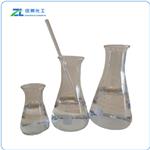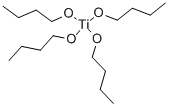The catalytic properties of Tetrabutyl titanate
Nov 6,2023
Description
Tetrabutyl titanate is a useful organic compound with the chemical formula C16H36O4Ti. This compound is commonly used as a catalyst. It is able to improve the adhesion of coatings, rubber, and plastics to metal surfaces.

As a catalyst
Compared with organotin catalyst which is able to catalyze the synthesis of adipic acid-based polyesters, tetrabutyl titanate has many advantages, such as high catalytic activity, high efficiency, and non-pollution. Tetrabutyl titanate can improve the brightness and transparency of polyester and is widely used in catalyzing the esterification reaction between acid and polyols.
In 1986, Hsu et al. studied the kinetics of tetrabutyl titanate catalyzed transesterification of dimethyl terephthalate (DMT) with 1,4-butanediol. They found that the methyl ester groups on DMT and MHBT have equal reactivities for [BD]/ [DMT] > 2 and up to about 75% conversion with tetrabutyl titanate as a catalyst. To be specific, their test of zinc acetate and tetrabutyl titanate indicates that the latter is the more efficient transesterification catalyst for the DMT-BD system, although zinc acetate is widely used for the transesterification of DMT with ethylene glycol in the poly(ethy1ene terephthalate) (PET) process.
Reaction mechanism
After that, Chen et al. used tetrabutyl titanate [Ti(OBu)4] as a catalyst in the esterification reaction between adipic acid (AA) and ethylene glycol (EG). In this study, they propose the esterification reaction mechanism. First, AA reacts with the catalyst to quickly generate a complex (I) by the coordinate bond between the titanium atom (low electronegativity) in [Ti(OBu)4] and the carbonyl oxygen (high electronegativity) in AA and the hydrogen bond between the hydrogen atom in the carboxyl and the oxygen atom in [Ti(OBu)4]. In the complex (I), the electronegativity of carbonyl carbon reduces due to the electrophilic effect of the coordinate bond, so when it reacts with EG, a new complex (II) is gradually formed by the coordinate bond between the carbonyl carbon and the hydroxyl oxygen in EG and the hydrogen bond between the hydroxyl oxygen in AA and the hydroxyl hydrogen in EG. Afterward, the monoester quickly forms via the rearrangement of the coordinate bond and the hydrogen bond in complex II; meanwhile, complex II loses one molecule of water. Finally, the diester forms via the reaction of monoester and EG catalyzed by [Ti(OBu)4] following the same mechanism as above.
Used in waterborne coating
The molecular structure of the cross-linking agent determines the cross-link mode of the waterborne epoxy resin. Since OH groups could be active groups that could contribute to increasing the cross-link density of the epoxy resin. Zhou's group has developed a novel titanium ion a cross-link agent by modifying tetra-n-butyl titanate with ethylene glycol and tris(2-hydroxyethyl) amine. The agent-initiated double cross-link greatly increased the cross-linking density of waterborne acrylic-epoxy resin and increased the impedance from 106Ωcm2 to 108Ωcm2. After 30 days of immersion, the NaCl solution passed through the coating without the cross-linking agent, causing the substrate to corrode, while all the coatings with a cross-linking agent could protect the substrate well.
References
[1]Chen, et al. "Mechanism and kinetics of esterification of adipic acid and ethylene glycol by tetrabutyl titanate catalyst."Korean Journal of Chemical Engineering(2018).
[2]J., et al. "Kinetics of transesterification of dimethyl terephthalate with 1,4-butanediol catalyzed by tetrabutyl titanate."Journal of Applied Polymer Science(1986).
[3] Xu, Lingli, et al. "Corrosion Resistance of Waterborne Epoxy Resin Coating Cross-Linked by Modified Tetrabutyl Titanate."Scanning2020(2020): 1-9.
- Related articles
- Related Qustion
The most common adverse reactions (≥35%) in pediatric patients were vomiting, nausea, diarrhea, abdominal pain, rash, vision disorder, upper respiratory tract infection, cough, pyrexia, musculoskeletal pain, fatigue, edema, constipation, an....
Nov 3,2023DrugsNADP, Disodium Salt is a vital coenzyme in cellular metabolism, redox reactions, and gene expression regulation with promising therapeutic potential.....
Nov 6,2023APITetrabutyl titanate
5593-70-4You may like
- The toxicity of Triethylene glycol
May 14, 2024
- Is 1,4-benzoquinone a toxicity compound?
May 11, 2024
- The Synthesis method and Toxicity of 18-Crown-6
May 10, 2024
Tetrabutyl titanate manufacturers
- Tetrabutyl orthotitanate
-

- $4500.00 / 1T
- 2024-05-27
- CAS:5593-70-4
- Min. Order: 1T
- Purity: 99%
- Supply Ability: 600T
- tetrabutyl titanate
-

- $10.00 / 1kg
- 2024-05-06
- CAS:5593-70-4
- Min. Order: 1kg
- Purity: 99%
- Supply Ability: 20ton
- Tetrabutyl titanate
-

- $0.00 / 1kg
- 2023-10-17
- CAS:5593-70-4
- Min. Order: 1kg
- Purity: 99%
- Supply Ability: 20tons




